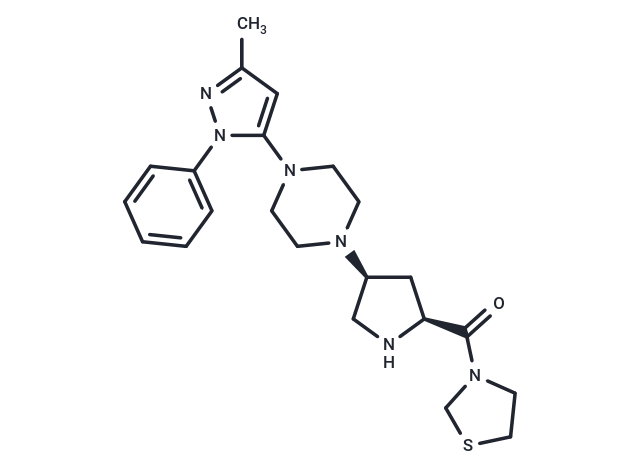Shopping Cart
Remove All Your shopping cart is currently empty
Your shopping cart is currently empty
Teneligliptin (MP-513) is a novel dipeptidyl peptidase 4 (DPP IV) inhibitor for the treatment of type 2 diabetes mellitus with hypoglycemic activity for the study of obesity and diabetes.

| Pack Size | Price | USA Warehouse | Global Warehouse | Quantity |
|---|---|---|---|---|
| 5 mg | $30 | In Stock | In Stock | |
| 10 mg | $40 | In Stock | In Stock | |
| 25 mg | $68 | In Stock | In Stock | |
| 50 mg | $98 | In Stock | In Stock | |
| 1 mL x 10 mM (in DMSO) | $43 | In Stock | In Stock |
| Description | Teneligliptin (MP-513) is a novel dipeptidyl peptidase 4 (DPP IV) inhibitor for the treatment of type 2 diabetes mellitus with hypoglycemic activity for the study of obesity and diabetes. |
| Targets&IC50 | DPP4 (human plasma):1.75 nM, DPP4 (human recombinant):0.406 nM (Ki), DPP4 (human recombinant):24 μM (Km), DPP4 (human recombinant):0.889 nM, DPP4 (human recombinant):6.06 nmol/min (Vmax), GLP1(7-36) amide:2.92 nM, DPP4 (rat plasma):1.35 nM |
| In vitro | Teneligliptin inhibits DPP-4 enzyme in a concentration-dependent manner. The IC50 values of Teneligliptin on human recombinant DPP4 (rhDPP-4), human plasma and rat plasma were 0.889 nM, 1.75 nM and 1.35 nM, respectively. The kinetics of enzyme inhibition by Teneligliptin was investigated using Gly-Pro-MCA as the substrate and rhDPP-4 as the enzyme source, and the Ki, Km and Vmax values were 0.406 nM, 24 μM and 6.06 nmol/min, respectively. Teneligliptin inhibited the degradation of GLP-1(7-36)amide with an IC50 value of 2.92 nM. [1] |
| In vivo | In Wistar rats, oral administration of Teneligliptin effectively inhibited plasma DPP-4 with an ED50 value of 0.41 mg/kg, and the inhibitory effect was sustained up to 24 hours after administration. Teneligliptin at a dose of 1 mg/kg significantly reduced triglyceride and free fatty acid fluctuations in an oral fat loading assay in Zucker rats. Zucker rats receiving Teneligliptin orally for two consecutive weeks demonstrated a reduction in blood glucose fluctuations in an oral glycemic load test, as well as a reduction in plasma triglyceride and free fatty acid levels in the non-fasting state. [1] In addition, Teneligliptin improved hepatic histopathological features and reduced intrahepatic triglyceride levels in a mouse model of nonalcoholic fatty liver disease, which was associated with downregulation of hepatic lipid synthesis-related genes induced by AMPK activation. [2] |
| Kinase Assay | DPP-4 inhibition assay is carried out using either 5 ng purified recombinant human DPP-4 (rhDPP-4), human plasma (20-fold diluted with assay buffer; phosphate-buffered saline (PBS) containing 0.003% Brij-35 solution), or rat plasma (10-fold diluted with assay buffer) Gly-Pro-MCA as a chromogenic substrate as described previously with slight modifications. DPP-4 inhibitors (Teneligliptin, Sitagliptin, and Vildagliptin) are diluted with assay buffer at several concentrations. Twenty microliters of inhibitor solution, 20 μL of the enzyme source, and 20 μL of Gly-Pro-MCA (final concentration, 25 μM) are mixed with 140 μL or 160 μL of assay buffer to initiate the enzyme reaction. After 20 min (rhDPP-4) or 1 h (plasma) at 37°C, the fluorescence intensity of 7-amino-4-methyl-coumarin (AMC) generated from Gly-Pro-MCA is measured using an automated microplate reader at 360 nm excitation and 465 nm emission. The fluorescence intensity of AMC corresponded to DPP-4 activity[1]. |
| Synonyms | MP-513, MP513 |
| Molecular Weight | 426.58 |
| Formula | C22H30N6OS |
| Cas No. | 760937-92-6 |
| Smiles | CC=1C=C(N(N1)C2=CC=CC=C2)N3CCN(CC3)[C@H]4C[C@@H](C(=O)N5CCSC5)NC4 |
| Storage | store at low temperature,keep away from moisture | Powder: -20°C for 3 years | In solvent: -80°C for 1 year | Shipping with blue ice/Shipping at ambient temperature. | |||||||||||||||||||||||||
| Solubility Information | DMSO: 20 mg/mL (46.88 mM), Sonication is recommended. | |||||||||||||||||||||||||
| In Vivo Formulation | 10% DMSO+40% PEG300+5% Tween 80+45% Saline: 2 mg/mL (4.69 mM), Sonication is recommended. Please add the solvents sequentially, clarifying the solution as much as possible before adding the next one. Dissolve by heating and/or sonication if necessary. Working solution is recommended to be prepared and used immediately. The formulation provided above is for reference purposes only. In vivo formulations may vary and should be modified based on specific experimental conditions. | |||||||||||||||||||||||||
Solution Preparation Table | ||||||||||||||||||||||||||
DMSO
| ||||||||||||||||||||||||||
| Size | Quantity | Unit Price | Amount | Operation |
|---|

Copyright © 2015-2025 TargetMol Chemicals Inc. All Rights Reserved.